Your Brand Launch: Naming
The Secret Behind Big Brands And How Entrepreneurs Can Learn From It
This was one of many topics I was asked about by a croatian startup site prior to the speech I gave two nights ago at the University of Zagreb for the Founder Institute. The interview was published in croatian, which you can peruse here if you speak the language (and want to analyze and help me understand why the Backstreet Boys invaded my Brand Atmosphere), but for the rest of you, here it is:
Startups, especially the ones you will be talking to in Zagreb, are mainly in their early stages. Do they even need branding in that stage? If they do – what kind of branding do they need?
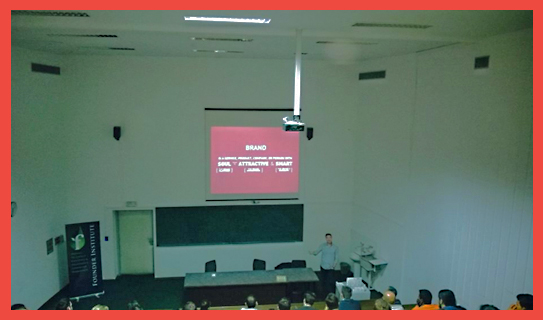
Fabian Geyrhalter speaking at the University of Zagreb for the Founder Institute, October 22, 2014
How can you brand yourself online when you are still a small startup, with a very small team and a limited budget?
When is the right time to hire someone (or a company) to help with branding?
Can you put together some sort of “emergency branding kit” for startups? What would that “kit” be made of?
It gets really difficult for a startup to choose their company name. It has to be unique, it has to be international, it needs to mean something. How do you achieve all of that and more with just one word?
How can a startup’s target audience help with forming a brand? What kind of feedback can that audience provide and how can a startup brand create an emotional connection with their potential customers?
What is the secret behind those huge, well known and beloved brands and what can small startups learn from them?
4 Crucial Steps You Need To Take Before Crafting Your New Venture’s Logo
Don’t hire us to create your logo. Not us, nor anyone else therefor. Sure, we could create a great logo for you. It would look timeless, be very well designed (I believe we are one of the best, and many agree), it would work across platforms and for years to come, and everybody would be telling you how much they love it. So why shouldn’t you hire us to create this important piece of branding for you?
Chances are you don’t need a logo designed. Not yet.
Chances are you need a brand built, and your logo is just a part of it. By creating a logo in a vacuum, and out of sync, you will likely fail. I don’t want you to fail. Nor be part of failure. I think we share this belief as entrepreneurs.
It’s the cart before the horse idiom: Why put the horse in place if we don’t know the message by the messenger yet?
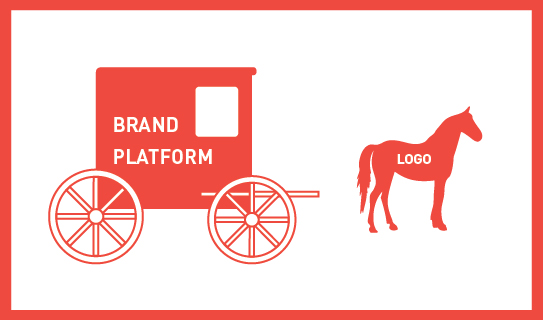
Below are 4 key elements you have to have in place prior to embarking on your logo design; they are the bare minimum requirements, the wheels of your cart so to speak:
1. You have a positioning statement in place that focuses on the ‘why’ and you stand tall behind it
2. You created 3 target audience personas that stand for who you are actually talking to/with
3. You know your brand personality and its associated keywords and are ready to act upon it
4. You have created a meaningful name that responds successfully to all of the above
If you don’t have these in place, creating a logo would be wasting your money, and (y)our time. It’s a lose-lose situation. How would any designer know what to design without these in place; how would the logo convey what it needed to convey; and finally, how could it connect with your audience? I don’t know, but I see it happen every day on the client’s expense.
Contact us if you need help getting there, as we love to assist and contribute, while speeding up that journey to your brand image.
Talk Talk – Talk Talk (Sound Naming Advice)
Do you remember this song? Talk Talk by the highly influential 80’s band Talk Talk?
That’s right, you do. It was rather memorable. Lucky for them, as they named their first song on their first album (their second single release) after their newly formed band.
That takes real guts.
And guts can result in glory…or defeat. Brutal defeat that is. A risk that many new ventures are willing to take when they name their product the same as their company, or vice versa. It is a move that most often is based on a swift launch. Rarely is the decision to name an offering and its company alike a choice of strategic nature.
When Talk Talk decided to choose Talk Talk for their ‘inaugural song’, there was a risk involved in case the song sucked, but the band had a decent amount of control over that. The song did not suck, instead it defined a sound that they built their entire career on. You hear Talk Talk (Company Name) and you automatically hear the song Talk Talk (Product Name) in your ears. Smart move.
In the entrepreneurial world though, betting on your one product to turn into a hit is a gamble that only gets amplified once you decide to diversify your portfolio of offerings down the road. Levi’s had a major hit with their jeans, then they tried selling khakis and failed doing so under their brand name; they had to create Dockers.
Here’s to you, Talk Talk, for tempting entrepreneurs to take this risk. For the ones that aspire to lead through brand strategy though, you may peruse our white paper on brand architecture instead (while listening to any 80’s hit of your choosing).
Brand Naming: Guess Who ‘Blue It’? A Lot Of Them Did.
When I caught up with our long-term collaborator Matt Dandurand of Media Contour the other day he mentioned that he came across a breed of hilariously ‘mis-named’ IT companies. He had to share this phenomenon with me as it was very hilarious, yet so awfully sad at the same time, and he insisted that I dedicate a blog post to it that can turn this whole thing into something educational for my readers.
I was doubtful.
Then Matt shared how, during some research he was conducting on IT companies, he came across a company named ‘Blue IT’. He thought it was funny, especially when typing the url. A quick Google search later he found a slew of them that blew it, all the same way.
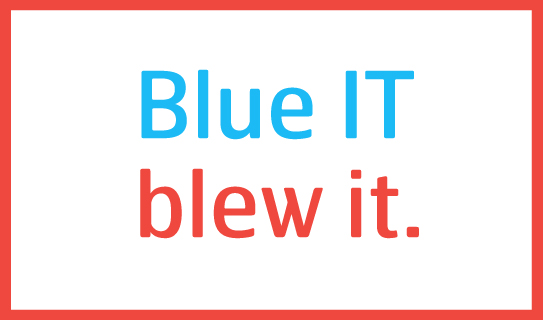
Now I am not in the business of picking on a random company’s name, it seems a bit cheap, but I do feel this serves as a great pointer to the fact that naming is to be taken seriously, regardless of company size and industry. Ample time needs to be spent to ensure, yes, that you don’t blow it. This guide will help you. It focuses on what makes a great brand name, now that we know what makes an unfortunate one.
The True Tech Startup Trend: Cloned Apples From Cloned Trees
Many tech startup founders pitch their project by saying ‘It’s just like Instagram, but with [filling in their differentiator],’ or, ‘Imagine Pinterest, but only [filling in their differentiator]’. Quite peculiar, most of them are located in places like Silicon Alley, Silicon Hill or Silicon Forest.
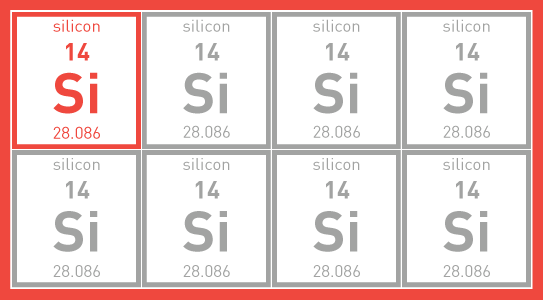
With ‘startup’ being the thing to do for many (particularly right out of college) this hot minute, it is the idea of starting something (anything really) that is often greater than the business idea in itself. Innovations turned into variations of the same, leaving the invention behind, while startup meccas themselves turned to cloned names: Silicon Alley (New York), Silicon Beach (Los Angeles’ West Side – Note: we pushed for the name Tech Coast), Silicon Roundabout (London), Silicon Forest (Portland), Silicon Hill (Washington D.C.) not to be mistaken with Silicon Hills (Austin), Silicon Border (Mexicali), Silicon Sloboda (Moscow) and many more.
Silicon Valley was named after the prosperous semiconductor manufacturers that were inhabiting the surrounding San Francisco area in the 1970’s. Today, as too many Silicon Valley clones are churning out too many Snapchat clones, it is time to remind ourselves what Silicon Valley was named after: An element; and there are no two elements that are alike. Silicon as an element only exists once. The periodic table is yours to experiment with.
Time to get creative. I can’t wait to hear about, better yet, be part of that journey.
CATEGORIES: Startup Advice Your Brand Launch: Naming
Rapid-Fire Brand Name Advice
On this blog I already talked about what makes a name successful and how to pick a domain name, but many of you ask if I find a fabricated name to be superior to a descriptive name, and how to best navigate the types of names that one can consider, quickly. Short and actionable, I’ll give one sentence of advice on each type of name. 3, 2, 1, go:
Descriptive
Example: Match.com
Advice: Great as it immediately conveys what it is/does – only if you will never expand your product offerings – but limiting and hard to find a sound domain name
Metaphor
Example: Puma
Advice: Not a top choice as existing connotations, domain name difficulties and Search Engine results can quickly come in the way for a new company
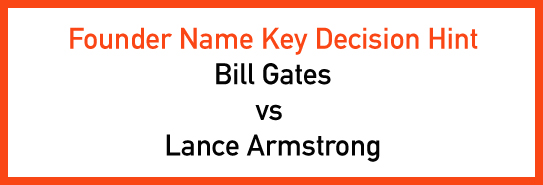
Founder
Example: The Bill & Melinda Gates Foundation
Advice: Great if you are the brand, you already have a legacy and if you are Bill, and not Lance
Fabricated
Example: FINIEN
Advice: It’s genius, of course! In all seriousness, it is a great path, if easy to pronounce and recall, and backed by a great story
Acronym
Example: AOL (America On-Line, Remember?)
Advice: A solid option to sound like a larger company from the start; only if your customers can recall your letters and if you can get hold of a reasonable domain name (sorry, three- or four-letter combos are all sold out)
Fabricated x Acronym
Example: Wanelo (Want, Need, Love)
Advice: Great option if tied to a tag line – otherwise the same criteria applies as with Fabricated names
Creative Spelling
Example: Lyft
Advice: Don’t do it, it’s pure laziness – unless word of mouth is not important to you (Wait, you spell it just like Supply but with a v instead of the u?) and you cater solely to ages 18-28
Numeric
Example: 7-Eleven
Advice: Don’t do it out of laziness (I picked our street number, easy does it) as no one will recall it – do it only if you can create shared meaning (7-Eleven: open 7 – 11, 7 days a week) or showcase value (Social 123 – easy as 1-2-3). See my post on numeric names for details.
There you go – no more excuses. Just do it, or dig deeper via our white paper, or if all fails (or you have better things to do, like starting a business) call me for help, or call us for hands-on naming magic.
CATEGORIES: Startup Advice Your Brand Launch: Naming
How to Leverage the 3 Core Components of Your Brand Identity to Enhance Messaging
When we think of brand we first think of logo (even though we know a brand is much more than its logo). The logo is the key point of visual interaction with a brand, hence we are likely to recall it every time we think (or talk) of – or write about – a brand.
During the brand identity (‘logo‘) design process entrepreneurs often forget that there are 2 other elements that help tell the company or product’s story. They interact and bring value to the brand identity as a whole. Do not repeat the same message, but instead ensure to leverage these 3 core components to create a stronger, deeper brand message:
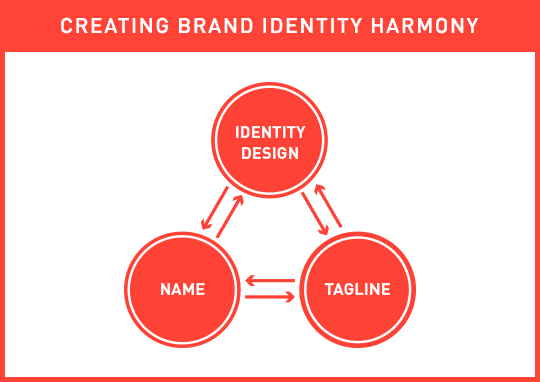
The 3 core brand identity components need to complement each other, each adding something unique to the whole story, and together forming a cohesive and strong initial brand message.
If your name describes your business, do not focus on showing the same message in your logo; instead use your logo to talk about other key elements that describe and differentiate your business. If you are in the cloud storage business and your name includes the two words cloud and storage (A bad company name, yet good example: Cloud Storage Ninjas), have your logo visualize security and stability, if those are key components of your brand’s message. Contrary, if your name is nondescript, either fabricated or an acronym, ensure that the associated brand identity design visualizes what you are in business for (EG: “Cloud Storage“).
Often forgotten during the brand identity design process (and beyond) is…the tagline. There are many factors to blame for the slowly occurring extinction of the tagline (mainly of digital nature, as tag lines are hard to squeeze into apps and templated web sites), but the power of a great tagline is still immense (Just do it, I say!). The tagline should be alive and kicking even though its placement has changed (from the traditional place below the brand identity design). It can now be used as the first header users see on a brand’s web site, the descriptor below the company name in an email signature, in place of yet another step-and-repeat icon pattern on a back of a business card, or in the often underestimated – yet early – brand touch point, the lobby of a business. The tag line is a powerful tool, that, together with the name and brand identity design, tells a stronger, deeper and more actionable initial brand story. It is a leading actor and you can write the script.
Keep the bigger picture in mind when embarking on your identity design project and use your Brand Platform to ensure these 3 core elements touch on more than just one or two of your core values and differentiators (while keeping it visually simple).
Next week I will talk about why our identity design looks the way it does. Are we not following our own rules, are we lazy, or is there a different strategy at play? Hint: It’s the latter.
Building Your Brand From The Ground Up (A Fireside Chat With Yours Truly)
A couple of weeks ago, Bob Garlick, host of Business Book Talk (poking through below), contacted me to schedule an interview about our book ‘How to Launch a Brand.’ With Bob sitting in Vancouver and myself in Los Angeles, I was immediately taken by surprise as there was no script that he shared with me, no canned answers to prep, no warmup chatter and no edits were made to our conversation.

The result is an honest and stimulating conversation between two individuals with a keen interest in design, branding and entrepreneurship, which I’d like to share with you. Below audio not only gives you a peek into our book, but also covers topics such as misconceptions of branding, brand strategy, how brands need to be different than 15 years ago and how to connect with your customers through branding:
Audio clip: Adobe Flash Player (version 9 or above) is required to play this audio clip. Download the latest version here. You also need to have JavaScript enabled in your browser.
(Can’t see above audio player in your E-Mail? Please listen to the audio via our site)
Now that I crossed the bridge by posting audio (how adventurous), I might as well share a quick video in which I further define ‘brand’ specifically for startups, filmed at a mentoring session (how advantageous) at the Founder Institute in San Diego two weeks ago.
Damage Control For The Misused And Abused Word ‘Brand’
“The word ‘brand’ needs a re-branding – due to its brand longevity the brand legacy is not brand-correct anymore,” I heard myself say unexpectedly in an interview earlier this week. It has been on my mind for a while. To no surprise, running a brand consultancy I am using the word a hundred times a day. Furthermore I just published a book titled ‘How to Launch a Brand’. The word gets tiring, especially since it leaves a bad aftertaste and I feel the need to first convince people that it is not a bad term before I start talking about it any further. Brand is not a four letter word.
Despite the negative connotations with the term, branding is more important today than it has ever been before and it is not only consumed, but furthermore created and curated by the masses through their very own personal (public/social media) brand. Brand is alive and kicking and we will not be able to change the term, but one can change the perception away from luxury good logos (Gucci, Chanel) and larger-than-life corporations seen as evil-doers (Exxon, Walmart) to a modern necessity, which, if created and nurtured in an honest and authentic way, turns ‘brand’ into a holistic ‘aura’ of a product/service provider (or person) that we are allowed to have admiration for (From an iPhone to a Celebrity), aspiration towards (From a Nonprofit to a highly ranked University) and sometimes draw inspiration from (From Ted Talk to Oprah).
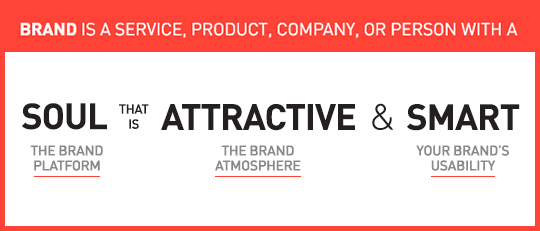
To me, a brand is a service, product, company, or person with soul, that is attractive and smart.
1. Soul is the beating heart, the reason a company should exist and why your initial attraction matures into love. You put your trust in brands with a soul and most often your money follows soon thereafter. Not much different than with human relationships, soul is the reason why we care for each other, or a particular brand.
2. Attractive is the brand aura that allows for the gut instinct emotional connection you feel when getting in contact with the brand. It is the design and the voice that is carefully created and curated over time in a particularly consistent manner. Attraction is not to be mistaken by shallow beauty.
3. Smart is its usability. How easy is it to engage with the company/product/service/person? In the tech industry it is User Interface and User Experience, with consumer products it is the product and packaging design and with services it is often the design of key offerings combined with its delivery.
Now that we ‘talked’ about the complex strategy that creates the beautiful simplicity that makes a brand, maybe we should give the word another chance?
Car Naming VS Auto Naming: Are Real Names Superior to Alphanumeric Names?
Car names run the gamut from great names that evoke strong imagery and emotion like “Mustang” via alphanumeric naming systems to underwhelming names like “Golf” that fall flat and fail to impart a personality. What is behind these sometimes great, but more often bizarre naming strategies of these car companies? Inspired by a late night conversation I had with the CMO of a large European car brand the other day, the question lingered and I had to dig deeper:
A broad overview of naming strategies in the automotive industry reveals that mid-price companies like Volkswagen, Toyota, and the European car company Skoda opt for either using real words as names — a lá Toyota “Land Cruiser” — or made up names like Volkswagen “Jetta”. Higher-end brands like BMW and Lexus tend to use an alphanumeric naming strategy. By using real names, the consumer connects with the model of the car: A driver of a Ford Mustang is more likely to say “I drive a Mustang” as opposed to “I drive a Ford”. Alphanumeric names tend to place the emphasis on the make of the car, the brand, over the model: A driver of a Lexus is much more likely to report “I drive a Lexus” than to say “I drive an ES”. That is the power of Alphanumeric names, yet its downfall is that they offer little emotional connection to the actual car model and most often lead to frustrating confusion during the shopping process.
As you climb to the top of the pricing scale, with ultra luxury vehicles such as Bentley and Rolls Royce, the strategy of using real names and/or fabricated words for vehicles comes back into play. Words such as Phantom, Ghost, and Wraith depict the current line of Rolls Royce vehicles conveying a sense of mystery and intrigue.
Here is our round-up of the top 5 best car names and the top 5 flat tired names. We focused on ‘real’ names and not ‘auto’ names (as I may call them, pun and all) as the 750 Li Sedan (BMW) VS the IS 350 F Sport (Lexus) might have bored you.
What do you think? Did we miss any?
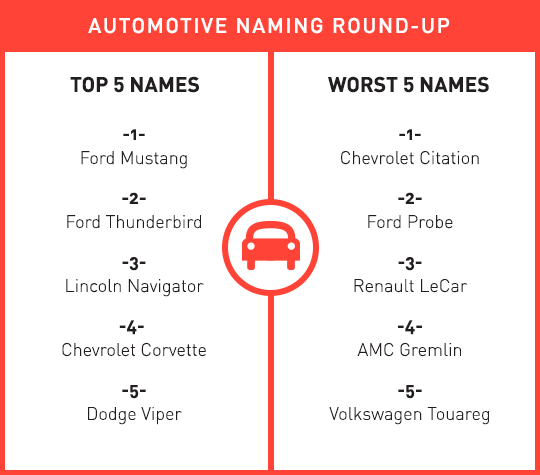
CATEGORIES: Blog Your Brand Launch: Naming



